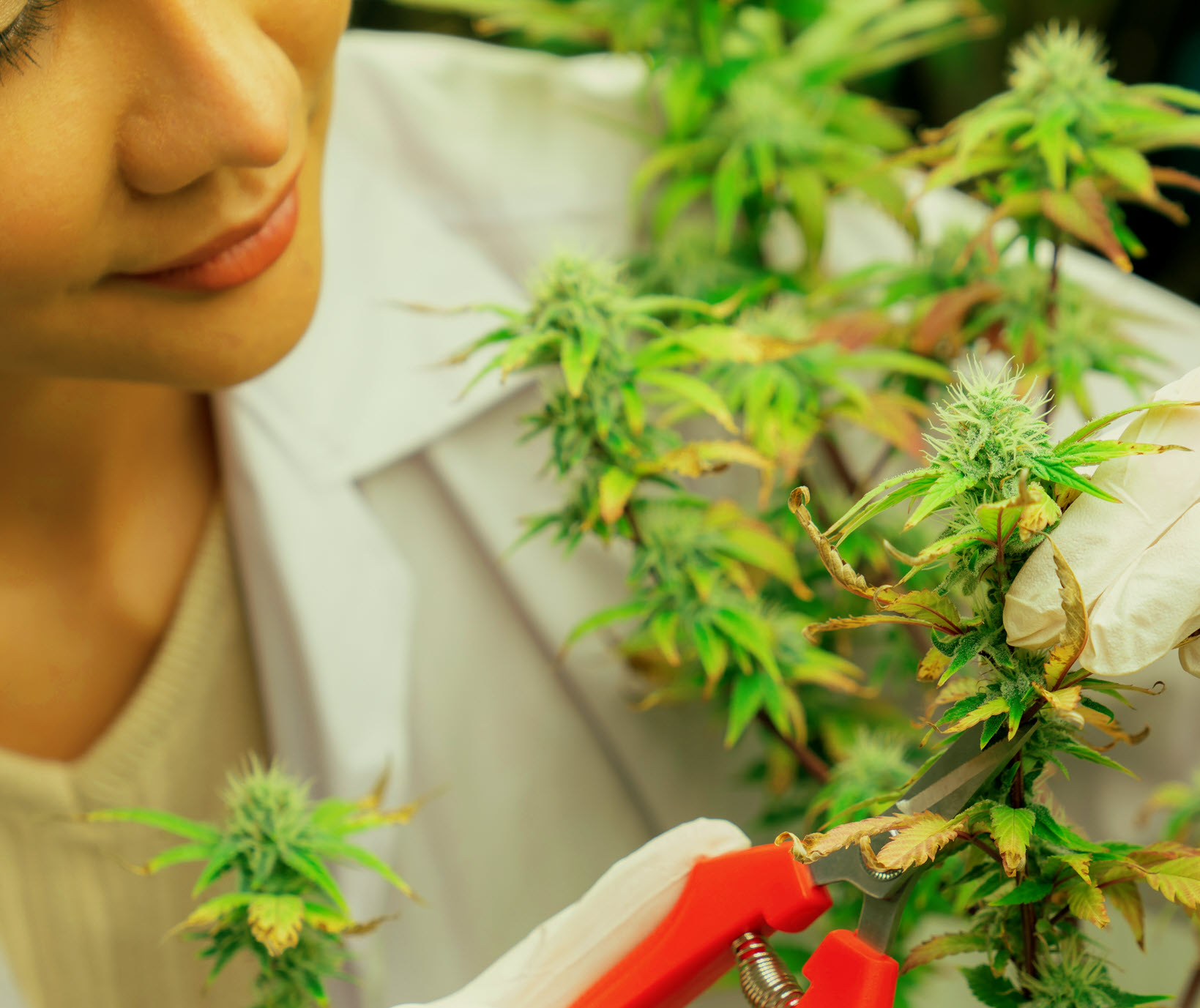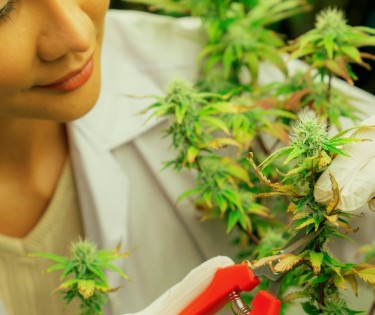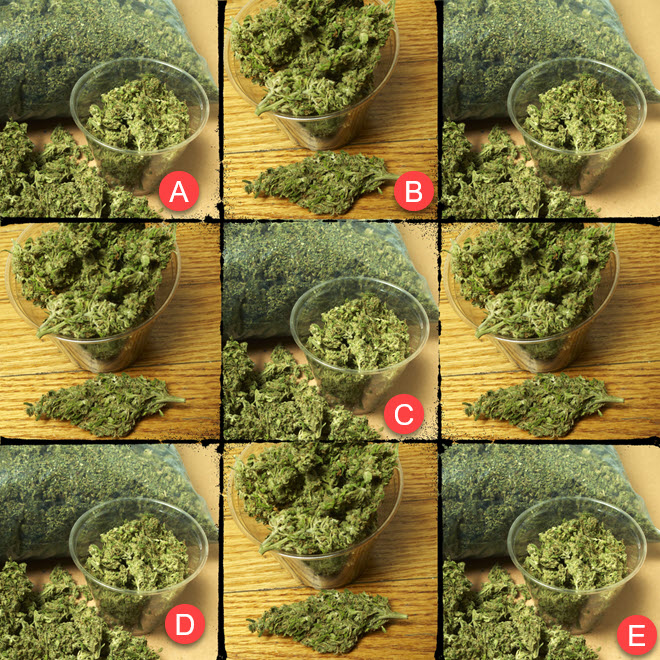Cannabis News
The Death of a Marijuana Worker
Published
1 year agoon
By
admin

While most occupations avoid headline-grabbing gore, innocuous vocations still inflict insidious damage through airborne threats eroding lung function over years. The phantom menace of ambient workplace toxicity carries an untold toll – including risk of sudden asphyxiation when cumulative exposures trigger acute attacks.
Consider “baker’s lung” – an asthma-like inflammation that develops from inhaling airborne grain and flour particles. This chronic disease forced many passionate artisans to abandon their craft over suffocating distress.
Hair stylists face analogous respiratory risks from potent chemical fumes permeating salons daily, as do factory workers breathing manufacturing particulates. The hazardous substances differ but the outcome feels identical – airways constricting and careers crushed through no direct misstep of their own.
In most cases, safety guidelines and equipment lag behind scientific understanding of emerging environmental illnesses. Thus, regulatory cracks allow once benign-seeming jobs to turn tragic before precautions adapt. Attributing blame becomes complex when unintended aspects of simple work carry unintended negative health consequences over time.
This ongoing issue underlies the first reported death of a cannabis industry worker recently – a 27 year old woman in Massachusetts suffered fatal asthma attack allegedly induced by workplace irritant exposure after previously managing her condition fine.
While the budding cannabis production sector hardly evokes hazards on par with industrial meatpacking or mine drilling, it still breeds its own singular risks, as regulators race to understand. When prohibition gives way to mass cultivation, new variables emerge.
So today, we will explore this tragic accident within its broader context – well-meaning workers undone by latent threats in substances at first sniff seemingly harmless enough. But when health hangs in the balance of unknowns, caution takes on grave urgency.
Let us honor this woman’s memory then by scrutinizing the growing pains of an industry rushing to meet demand. If preventing the next victim means pausing enthusiasm for patient access, the tradeoff seems clear. For in the end, no reefer revolution succeeds on backs broken laboring in shadows.
First, do no harm.
This young woman’s tragic death represents a watershed moment for the nascent cannabis industry to mature its ethical priorities around worker safety. While an individual loss first and foremost, her unnecessary passing will undoubtedly save future lives through forcing regulatory awareness and accountability.
Inspectors noted the facility had not established respiratory protections for staff handling volumes of agitated cannabis dust hazardous to compromised systems. But in fairness, few viability guidelines existed around large-scale commercial cultivation when early operators raced to capitalize on legalization. But playing the devil’s advocate – it might be kind of obvious to ensure worker’s protections in an enclosed space with plant matter floating in the air.
The vast underground cannabis production knowledge understandably emphasized concealment and profitability over governance with workplace hazards an afterthought. Now that full legitimacy and scalability replaces shadowy improvisation, codifying revised best practices falls on regulators.
This expectant shift from illicit business to regulated corporate enterprise was bound to endure painful lessons given the pace of social change outpacing bureaucratic preparations.
But through those legislative growing pains, let us at least extract meaning from suffering to bless broader communities. Industry crucibles should purify, not corrupt, our integrity.
With cannabis governance still evolving conceptually, what better opportunity to embed safety-first regulatory models before harmful norms cement? Other sectors have learned similar lessons too late after normalizing harm. Cannabis need not repeat history’s errors.
This tragedy powerfully demonstrates why writing compassion into policy protects all. And if legacy operators wish to speak convincingly about ethical industry standards, addressing worker welfare makes the perfect starting point.
May this loss provide the urgent impetus to build cannabis production regulations correctly the first time as exemplary frameworks prioritizing people over profits. That outcome would make this woman’s unwarranted death not in vain, but an indispensable catalyst bettering society.
While the cannabis worker’s death has raised concerns around respiratory risks from mass cultivation, her underlying asthma represents an often minimized health crisis facing over 25 million Americans today. Asthma proves one of the nation’s most common, underestimated and deadly chronic conditions.
Over 10% of American adults suffer asthma currently, with rates highest among minorities and women. Triggers range from allergy irritants to pollution to respiratory infections. But outcomes can quickly turn fatal without proper prevention and treatment.
In fact, a shocking 39% of asthmatic adults reported experiencing attacks recently, signaling vast unmet care needs. And after decades of declines, death tolls are actually rising again, taking ten lives daily.
Behind those abstract figures lie needless everyday suffering and lost livelihoods as asthma constricts once active lives. Simple tasks turn laborious amidst terrifying bouts of breathlessness. And the condition worsens over time without tight symptom control.
Too often the social stigma around asthma invites blame, minimizing its trauma as an imagined ailment instead of recognizing its lethal reality. Yet epidemiology shows no group immune from onset as inflammation disables airways without warning.
Even physically fit individuals find themselves unexpectedly hospitalized, bedridden for weeks after sudden attacks. If the pandemic taught anything, breath stands among our most precious assumed attributes until compromised.
And marginalized groups shoulder the harshest asthma impacts, facing eroded quality of life and early death – especially Black women. These unjust outcomes demand policy attention on par with splashier diseases like COVID but of course, the treatment options aren’t always pharmaceutical – there are practical methods of working with the lungs and strengthening it. In fact, asthmatics should totally do breathwork!
Yet care infrastructure remains sorely lacking for proper asthma management beyond quick-fix inhalers and emergency interventions. Patients lack sustained access to preventative anti-inflammatory regimens, home air purifiers, allergen avoidance education and mental healthcare.
In this woman’s case, the risks tragically proved insurmountable given workplace irritant exposures. But better safety regulations alongside elevated clinical treatment could have prevented such catastrophe.
Ultimately her death illuminates twin priorities – destigmatizing asthma as easily managed while strengthening societal infrastructure supporting patients long-term. Because the occasional frightening attacks hide in plain sight chronic day-to-day ordeals for millions that our healthcare system continues neglecting at their peril, sometimes fatally.
This young woman’s sudden passing at 27 over an invisible workplace threat sparks calls to balance cannabis reform zeal with cautions of unintended consequences from breakneck policy change. But ultimately all sides share the goal of preventing such needless loss.
And from crisis wisdom crystallizes. Asthma safety protocols will now enter cultivation facility regulations to protect other vulnerable industry laborers. Her legacy thus uplifts colleagues through institutional evolution she helped initiate.
The sticky truth remains that prohibition’s end creates new dialogue around health tradeoffs from increased access and production. But reasonable guardrails arise through compassionate debate, not scare tactics demonizing the plant itself.
With cannabis, as all medicines, responsible frameworks honoring human dignity over profit must prevail. And each tragedy underlines the work remaining to place community wellbeing first amidst commercialized healthcare.
Yet as we walk this complex path together, broader perspective seems vital too – that life’s impermanence claims all fates regardless of circumstance. However graciously lived, no mortal bypasses death in the end.
So this incident should remind us as bystanders to love boldly, forgive freely, speak kindly, waste no days in grievance. For in between first breath and last, meaning weaves through bonds nurturing each other against the endless entropy.
Few depart expecting their curtain call so soon or suddenly. But in that obscurity lies wisdom to consciously cherish each transient now beyond assumed tomorrows. The thriving cannabis movement must model this mindfulness.
Honor this woman then by embedding vigilance into your protocols and presence into your days. Uplift colleagues through purposeful work culture. Allow loss to reveal life’s urgency. The rest flows through awakened hearts connected to transient blessings blooming all around if we pause to perceive them.
CANNABIS DUST IN THE AIR, READ ON…
You may like
-


Cannabis Can Keep You From Freaking Out About Kessler Syndrome
-


2025: The Year of Growing Your Own Cannabis
-


How Much Does an Ounce of Weed Cost Starting 2025? A. $74 B. $150 C. $257 D. $300
-


What is the economic outlook for marijuana companies in 2025?
-


Alert: We are just over a week away from the Natural Medicine Division opening our application process to individuals who are interested in becoming business Owners or Natural Medicine Handlers, and to business applications for Healing Centers, Cultivations, Testing Facilities and Product Manufacturers.
-


Cannabis And Co2 – How To Increase Your Yield
Cannabis News
2025: The Year of Growing Your Own Cannabis
Published
14 hours agoon
December 27, 2024By
admin

5 Reasons to Grow Your Own Weed in 2025
Let me share a little secret with you – they say smoking weed isn’t addictive, but growing it? That’s a different story altogether! As someone who’s spent countless hours tending to cannabis plants, I can tell you that there’s something absolutely mesmerizing about watching a tiny seed transform into a magnificent, aromatic flower. It’s a hobby that can quickly become an obsession, but in the best possible way.
Yet here’s the interesting thing: despite the increasing legalization of cannabis across the globe, the vast majority of consumers will never experience the joy of growing their own. They’ll continue buying their stash from dispensaries or their friendly neighborhood dealer, which is perfectly fine! Cannabis cultivation isn’t for everyone – it requires patience, dedication, and a genuine interest in the process.
But I know some of you out there have been flirting with the idea. Maybe you’ve caught yourself watching growing videos on YouTube at 2 AM, or perhaps you’ve been calculating how many plants you could fit in that spare closet. You’ve been wanting to take the plunge but haven’t quite found the motivation to start. Well, my friends, 2025 might just be your year.
In this article, I’m going to give you five compelling reasons why 2025 is the perfect time to start your home growing journey. Whether you’re tired of dispensary prices, curious about different strains, or just want to connect more deeply with this magnificent plant, I’ve got some insights that might just convince you to cross over to the green side.
So grab your favorite piece, pack a bowl of whatever you’ve got handy, and let me tell you why 2025 could be the year you finally become the cannabis cultivator you’ve been dreaming of being. Trust me, you’ll want to hear this!
If you haven’t noticed that things have gotten ridiculously expensive lately, you’ve probably been living under a rock. The reality of inflation has hit us all hard, and here’s a sobering fact: $10 today is equivalent to what $7.41 bought you back in 2014. That’s nearly a 30% decrease in purchasing power! Every trip to the grocery store feels like a personal attack on your wallet these days.
While cannabis prices have remained relatively stable (thank goodness for small mercies), it’s everything else that’s eating into our budgets. That takeout you used to grab without thinking twice? That casual shopping trip for essentials? They’re all taking bigger bites out of your funds, and let’s be honest – it’s probably starting to nibble away at your precious weed budget too.
But here’s where growing your own becomes a financial game-changer. Yes, there’s an initial investment – we’re talking about a decent grow tent, some good lights, and basic equipment. But think about it: with a modest setup capable of housing six plants, you could be harvesting 2-3 times per year. Even with conservative yields, that’s enough to keep your stash jar full and your wallet happier.
And here’s the kicker – once you’ve got your growing operation dialed in, you might want to consider investing in a rosin press. For a few hundred bucks, you can start pressing your own concentrates. Do you have any idea how much money that could save you in the long run? We’re talking about turning your home-grown flower into premium concentrates that would cost you an arm and a leg at the dispensary.
In these economically challenging times, becoming self-sufficient with your cannabis supply isn’t just a hobby – it’s a smart financial move.
There is something that every home grower knows but dispensary-only folks might not understand – there’s absolutely nothing that compares to smoking weed you’ve grown yourself. I mean, think about it: you were there from day one, watching that tiny seed crack open and reach for the light. You nursed that baby through every stage of growth, fought off those pesky spider mites, adjusted nutrients when the leaves started yellowing, and yes, maybe even sat there talking to your plants while enjoying a peaceful joint.
Speaking of talking to plants, science is starting to catch up with what growers have known for ages. Researchers have found that plants respond positively to music, with classical and rock tunes actually helping them grow faster. It’s not just some hippie nonsense – plants are genuinely responsive to their environment in ways we’re only beginning to understand.
In fact, recent studies suggest plants possess a form of consciousness or sentience. They respond to touch, sound, and even emotional energy. This means all those hours you spend doting on your grows, adjusting their environment, and yes, even those stoned conversations you have with them, might actually be affecting their development in positive ways.
When you grow your own cannabis with love and attention, you’re creating something special. You don’t have to worry about what pesticides might have been used, or whether your purchase is inadvertently supporting some shady operation. You know exactly what went into your plants – and more importantly, what didn’t.
The result? Weed that’s not just clean and potent, but carries the positive energy you invested in it. Ask any home grower and they’ll tell you – there’s something different about smoking bud you’ve nurtured yourself. It hits different, and I don’t just mean the effects. It’s a completely different experience when you know every trichome on those buds grew under your loving care.
there’s an incredible feeling that comes from smoking a strain that literally no one else in the world has ever experienced. It’s like being part of an exclusive club where you’re the only member. As someone who’s dabbled in breeding, I can tell you it’s one of the most rewarding aspects of growing your own.
Here’s where home growing gets really exciting: with just a handful of seeds and some basic knowledge, you can become a cannabis creator. Think about it – you’ve got that indica that helps you sleep like a baby, and that sativa that gets your creative juices flowing. What if you could combine those effects into your perfect, personalized strain? Well, you absolutely can!
Now, I know what you’re thinking: “Isn’t breeding cannabis complicated?” Sure, professional breeding with carefully selected traits and stabilized genetics takes skill and patience. But basic hybridization? It’s surprisingly straightforward. All you need is a male plant, a female plant, and a little bit of botanical matchmaking. When that male plant releases its pollen onto your chosen female’s flowers, you’re essentially creating a whole new variety of cannabis that’s never existed before.
Each seed from that union will be unique, carrying different combinations of their parents’ traits. Maybe some will lean more towards the relaxing effects of the indica parent, while others might express more of the sativa’s energetic qualities. It’s like opening a surprise package every time you grow one out – you never know exactly what you’re going to get, but it’s always exciting.
And hey, if you really get into it, who knows? With enough patience and practice, you might just develop the next award-winning strain. Stranger things have happened in the world of cannabis breeding!
As someone who appreciates every part of the cannabis plant, let me tell you about one of the most overlooked benefits of growing your own – hash production! While those pristine, crystal-covered buds might be your primary goal, there’s a whole world of possibilities hiding in those sugar leaves and smaller buds that some might consider “less than perfect.”
Here’s the beautiful thing about growing your own: nothing goes to waste. Those frosty sugar leaves that you’d normally trim away? That’s hash waiting to happen. Those smaller, popcorn buds that didn’t quite reach their full potential? They’re perfect candidates for hash making. And let me tell you, turning these “leftovers” into hash is nowhere near as complicated as you might think.
These days, there are plenty of hash-making kits available that make the process almost foolproof. Whether you’re interested in traditional dry-sift methods, ice-water extraction, or even pressing rosin, the equipment is readily available and surprisingly user-friendly. You don’t need a degree in chemistry to make quality hash – just some basic equipment and a little patience.
And let’s talk about the end product for a moment. There’s something magical about hash that just hits different. Even in this age of high-tech concentrates and fancy extracts, if someone pulls out some good hash, I’m always game. The intense flavor profile, the smooth smoke, the concentrated effects – it’s a classic for a reason. Rolling a joint with a sprinkle of your own homemade hash? That’s next-level satisfaction right there.
Look, if you’re already growing your own cannabis but not making hash, you’re leaving gold on the table. It’s like having a fruit tree and only eating the perfect specimens while ignoring perfectly good fruit that’s just a bit smaller or oddly shaped. Don’t be that grower – learn to make hash and thank me later!
You know, I might catch some flak for this, but I’ve got to say it – growing cannabis has taught me more about life than most self-help books I’ve read. And no, I’m not just talking about the practical stuff (though learning about pH levels and nutrient cycles is pretty fascinating). I’m talking about those deep, profound life lessons that seem to download directly into your consciousness while you’re just sitting there, staring at your plants.
There’s something almost meditative about tending to cannabis plants. You learn patience – and I mean real patience, not that “waiting for your DoorDash delivery” kind of patience. You understand that you can’t rush certain processes, that everything truly does have its season. No matter how much you want those buds to fatten up RIGHT NOW, nature operates on its own timeline, and respecting that rhythm is part of the journey.
I’ve spent countless hours just observing my plants, making minor adjustments, and in those quiet moments, some of my most profound realizations about life have bubbled up to the surface. Maybe it’s because growing cannabis forces you to slow down and pay attention to the subtle details. Or perhaps it’s because you’re literally nurturing life, watching this incredible plant develop from a tiny seed into something that can bring joy and healing to others.
Here’s what I think happens: when you’re focused on caring for your plants, your mind gets a break from the usual chaos of daily life. In that space, whether you’re adjusting your lights or checking trichomes, your thoughts have room to breathe and expand. You start noticing patterns, making connections, understanding cycles – not just in your grow room, but in your own life too.
I can’t fully explain why, but there’s something magical about growing cannabis that extends far beyond the plant itself. It’s like the process opens up new pathways in your mind, leading to a deeper appreciation for everything else in your life. And honestly? That might be the most valuable harvest of all.
Let me wrap this up with a sticky bottom line: I’m not here to pressure anyone into growing cannabis who isn’t already curious about it. This article is for those of you who’ve been sitting on the fence, watching growing videos late at night, and thinking, “Maybe I should give this a try.”
If that’s you, then let 2025 be your year to finally take the plunge. Whether it’s to save money, create your own unique strains, make some killer hash, or just connect more deeply with this amazing plant – growing your own cannabis can be one of the most rewarding experiences you’ll ever have.
Just remember to stay within your legal limits and don’t get too ambitious too quickly. The last thing you want is to end up in hot water because you got overly excited and turned your entire basement into a grow operation (yes, the temptation will be there!).
For those of you who decide to start this journey, I’m rooting for you! May your plants grow tall, your buds grow fat, and your first harvest be something truly special. Happy growing!
BENEFITS OF GROWING YOUR OWN STASH, READ ON…
Cannabis News
How Much Does an Ounce of Weed Cost Starting 2025? A. $74 B. $150 C. $257 D. $300
Published
15 hours agoon
December 27, 2024By
admin

As we approach 2025, the landscape of cannabis pricing continues to evolve, reflecting changes in legislation, market dynamics, and consumer preferences. Understanding the cost of an ounce of cannabis flower is essential for both consumers and industry stakeholders. This article delves into the factors influencing cannabis prices, regional variations across the United States, market trends, and predictions for the future.
The Current State of Cannabis Pricing
The cannabis market has undergone a significant transformation over the past decade. With the legalization of recreational and medical cannabis in numerous states, the industry has shifted from an underground economy to a regulated market. This transition has led to fluctuating prices as supply chains have developed and consumer demand has increased.
In states where cannabis has been legal for longer periods, such as California and Colorado, prices have stabilized due to established cultivation practices and robust distribution networks. Conversely, in newer markets like New Jersey and Connecticut, prices tend to be higher due to initial supply constraints and regulatory costs. Prices for cannabis in different countries can vary widely based on access and legalization.
Average Prices Across States
As of late 2024, the average price for an ounce of cannabis flower varies widely depending on the state. Here are some notable examples:
-
California: Approximately $74 per ounce
-
Michigan: Around $83.71 per ounce
-
Colorado: Roughly $150 per ounce
-
Illinois: About $257 per ounce
-
New Jersey: Over $300 per ounce
-
Connecticut: Similar to New Jersey, with prices exceeding $300
These figures illustrate how regional differences can significantly impact pricing. In states with mature markets and competitive pricing, consumers benefit from lower costs. In contrast, newer markets often see inflated prices due to limited supply and high demand.
Factors Influencing Cannabis Prices
Several key factors contribute to the pricing of cannabis flower:
1. Legalization and Regulation
The legal status of cannabis plays a crucial role in determining its price. States that have fully legalized cannabis for recreational use typically have lower prices due to increased competition among growers and retailers. Conversely, in states with strict regulations or limited licenses for cultivation and sales, prices tend to be higher.
2. Supply and Demand Dynamics
Like any commodity, the price of cannabis is heavily influenced by supply and demand. In regions where demand outstrips supply—often seen in newly legalized markets—prices can soar. As more growers enter the market and production ramps up, prices usually stabilize.
3. Quality and Strain Variability
Cannabis flower comes in various strains, each with unique characteristics affecting its price. High-quality strains with desirable effects or flavors may command premium prices compared to more common or lower-quality varieties. Additionally, organic or sustainably grown cannabis can also attract higher costs.
4. Production Costs
The cost of cultivation—including land, labor, equipment, and compliance with regulations—affects pricing. States with higher operational costs may see elevated prices for consumers. For instance, indoor cultivation requires significant investment in lighting and climate control systems.
5. Taxation
Cannabis is often subject to high taxes at multiple levels—state excise taxes, local taxes, and sales taxes—all of which contribute to final retail prices. For example, California imposes a 15% excise tax on cannabis sales in addition to local taxes.
Regional Pricing Trends
West Coast
The West Coast has long been a leader in cannabis cultivation and consumption. California remains one of the most competitive markets:
-
California: With an average price around $74, California benefits from a large number of licensed growers and retailers. The state’s established infrastructure allows for efficient distribution and lower costs.
Midwest
The Midwest is witnessing rapid growth in its cannabis market:
Northeast
The Northeast is experiencing a surge in interest as more states legalize cannabis:
-
New Jersey: With prices exceeding $300, New Jersey’s market is still developing post-legalization (2021). Regulatory hurdles have limited supply, contributing to higher costs.
South
The South remains largely conservative regarding cannabis laws:
Market Trends Leading into 2025
As we near 2025, several trends are shaping the future pricing landscape of cannabis flower:
As more states legalize cannabis—both medically and recreationally—the influx of new growers will likely lead to increased competition. This competition can drive down prices as cultivators seek to attract consumers with better deals.
Innovations in agricultural technology are making it easier and more efficient to grow cannabis. Techniques such as hydroponics and vertical farming can reduce production costs over time, potentially leading to lower retail prices.
As consumers become more educated about cannabis products, there is a growing preference for quality over quantity. This shift may lead to a bifurcation in the market where premium products command higher prices while lower-quality options become more affordable.
Regulatory Changes
Changes in legislation at both state and federal levels could impact pricing significantly. For instance, if federal legalization occurs before 2025, it could lead to greater interstate commerce opportunities and lower costs due to economies of scale.
Predictions for Cannabis Pricing by 2025
While predicting exact prices can be challenging due to numerous variables at play, several trends suggest potential outcomes:
1. Average Prices May Decrease: As competition increases across various states and production methods improve, average prices for an ounce of cannabis flower could decline significantly—potentially dropping below $100 in many mature markets.
2. New Markets Stabilizing Prices: As new markets mature (e.g., New York), we may see initial high prices stabilize as supply chains develop and competition increases among retailers.
3. Continued Premium Segment Growth: The premium segment of the market may continue to grow as consumers seek out high-quality strains with unique characteristics or organic certifications—potentially keeping some premium products priced above $300 per ounce even as average costs decline.
4. Impact of Federal Legalization: Should federal legalization occur by 2025, it could dramatically reshape pricing structures nationwide by allowing interstate commerce and reducing regulatory burdens on growers.
Conclusion
Entering 2025, the cost of an ounce of cannabis flower reflects a complex interplay of legal frameworks, market dynamics, consumer preferences, and production costs, with pronounced regional differences where some states enjoy lower average prices than others; however, the overall trend indicates increased competition that may lead to price reductions across many markets. As consumers become more discerning—favoring quality products over sheer volume—the industry is likely to evolve in response to these demands. Whether you are a casual user or a serious investor in the cannabis space, staying informed about these trends will be essential as we navigate this rapidly changing landscape together. In summary, while specific pricing predictions can vary based on numerous factors, including state regulations and market conditions, the general outlook suggests a promising future for consumers seeking affordable options and producers aiming for sustainable growth within this burgeoning industry.
HOW MUCH DOES AN 1 OZ. OF MARIJUANA COST? READ ON…
Cannabis News
25 Billion Reasons (and Counting) on Why Big Pharma Hates Marijuana Legalization
Published
3 days agoon
December 25, 2024By
admin

Real Reason Pharma Hates Weed
Sometimes I forget that not everyone has the same relationship with cannabis as I do. After spending over two decades researching, writing about, and experiencing the medical benefits of this remarkable plant, it’s become as normal to me as taking a daily vitamin. Cannabis is simply part of my wellness toolkit – a natural remedy that promotes balance and healing in ways that continue to amaze me.
But then I catch myself. I remember that for most of the world, cannabis still lurks in the shadows of illegality. Despite the growing wave of legalization, countless people remain in the dark about its therapeutic potential, their understanding clouded by decades of propaganda and misinformation.
Much of this ignorance can be traced back to Big Pharma’s influence over mainstream media and medical research. Through carefully crafted narratives and cherry-picked studies, they’ve painted cannabis as nothing more than a dangerous drug of abuse – just some “hippie grass” with no real medical value. It’s a masterful stroke of corporate manipulation that has kept millions from exploring this ancient medicine.
However, the truth has a way of emerging, especially in our digital age. Recent studies are painting a very different picture of cannabis – one that has pharmaceutical executives breaking out in cold sweats. Not only is cannabis proving effective for a wide range of conditions, but it’s also leading patients to reduce or eliminate their dependence on prescription medications.
Today, we’re going to explore these groundbreaking findings and expose the real reason Big Pharma is terrified of cannabis legalization. When you see the data on how this simple plant is impacting their bottom line, you’ll understand why they’ve fought so hard to keep it illegal.
So grab your favorite strain (if you’re in a legal state, of course), and let’s dive into the fascinating world of medicinal cannabis. What you’re about to learn might just change how you think about this controversial plant – and the companies trying to keep it out of your hands.
A groundbreaking yearlong study just published in the Journal of Pain and Palliative Care Pharmacotherapy has caught my attention, and believe me, it should catch yours too. The research followed 96 patients over 12 months, tracking their experiences with prescribed medical cannabis for chronic pain and mental health conditions. What they found wasn’t just impressive – it was downright revolutionary.
Let’s dive into the numbers, shall we? Within the first six months, patients reported significant pain reduction and improved mental well-being that continued throughout the entire year. We’re not talking about minor improvements here – a whopping 91% of participants reported their pain was “at least a little better,” with 75% declaring it was either “much better” or “very much better.”
But here’s where things get interesting, especially if you’re a pharmaceutical executive. By the study’s end, 55% of participants had reduced their prescription pain medication use, and 45% had cut back on over-the-counter pain medicines. The side effects? Mostly just dry mouth and sleepiness. Compare that to the novel-length list of potential complications from typical prescription pain medications.
And this isn’t an isolated finding. A separate review published in Cureus found that cannabinoids provided significant relief from chronic pain (33% versus 15% with placebo) with “minimal to no side effects.” The researchers went so far as to call it a “life-changing alternative” to conventional pharmaceuticals.
Another recent study revealed that 57% of patients with chronic musculoskeletal pain found cannabis more effective than their other analgesic medications, with 40% reducing their use of traditional painkillers after starting cannabis. The American Medical Association’s own research showed “significant improvements” in quality of life for people with chronic conditions like pain and insomnia, with effects “largely sustained” over time.
See the pattern emerging? Across multiple studies, we’re consistently seeing two things: cannabis works, and when it works, people need fewer pharmaceutical drugs. This isn’t just about pain medication either – patients reported decreasing their use of medications for depression, anxiety, and sleep problems too.
For those of us who understand cannabis, these findings aren’t surprising. But for Big Pharma, they’re absolutely terrifying. When half your patient base starts reducing their medication use by 40-55%, that’s not just a dent in profits – it’s a crater.
But here’s the kicker: the numbers I’ve just shared with you are just the tip of the iceberg. In our next segment, we’re going to translate these percentage drops in medication use into cold, hard cash. We’ll see exactly why pharmaceutical companies are spending millions lobbying against cannabis legalization, and trust me, when you see the figures, you’ll understand why they’re sweating.
Because let’s be honest – this isn’t about patient welfare anymore. It’s about protecting profit margins. And nothing threatens those margins quite like a plant people can grow in their backyard.
Let’s put these numbers into perspective, shall we? When we look at just one category of pharmaceutical drugs – say, prescription pain medications – we’re talking about a market worth over $25 billion annually. Now, imagine watching 40-55% of your customers walking away, choosing instead to use a plant they might be growing next to their tomatoes. That’s the nightmare Big Pharma is facing.
Research indicates that pharmaceutical companies lose approximately $10 billion annually in states with medical marijuana programs. And that’s just the tip of the proverbial iceberg. As more states legalize and more people discover cannabis’s therapeutic potential, these losses are projected to grow exponentially.
But here’s what really keeps pharmaceutical executives up at night: they can’t monopolize cannabis like they do with their synthetic drugs. Sure, they can create cannabis-based medications (and they are), but they can’t patent the plant itself. Mother Nature, in her infinite wisdom, made cannabis remarkably easy to grow and process.
Think about it – any moderately skilled home grower can produce a variety of cannabis medicines right in their backyard. Want to make a topical salve for arthritis? Just infuse some cannabis in coconut oil. Need something for sleep? You can make your own tincture. Looking for anti-inflammatory benefits without the high? Raw cannabis juice or leaves will do the trick. No pharmaceutical company required.
This accessibility terrifies Big Pharma because it completely circumvents their carefully controlled production and distribution systems. You don’t need a sophisticated laboratory or millions in equipment to create effective cannabis medicine. You need soil, water, sunlight, and a little knowledge passed down through generations of growers.
Even more threatening is cannabis’s versatility. One plant can potentially replace multiple medications. A patient might use cannabis to manage their chronic pain (goodbye opioids), help them sleep (see ya, Ambien), and ease their anxiety (farewell, Xanax). That’s three revenue streams dried up from a single plant growing in someone’s garden.
And let’s not forget about raw cannabis consumption – a method that completely bypasses the need for processing altogether. Raw cannabis contains THCA and CBDA (the acidic precursors to THC and CBD), along with hundreds of other beneficial compounds including terpenes and flavonoids. These compounds offer significant therapeutic benefits without any psychoactive effects, essentially giving patients a nutrient-dense superfood that doubles as medicine.
This is the real reason behind Big Pharma’s anti-cannabis stance. It’s not about safety concerns or public health – it’s about protecting their bottom line from a plant that threatens their entire business model. Cannabis represents everything they fear: a natural, effective medicine that people can grow themselves, process in their kitchens, and use to treat multiple conditions without ever stepping foot in a pharmacy.
No wonder they’re spending millions on lobbying against legalization. When your profit margin is threatened by a plant that literally grows like a weed, you’ve got a serious problem on your hands.
JG
Now let’s write a 350-word conclusion entitled, “The Sticky Bottom Line”
In this segment focus on:
* I believe that everyone should have access to medicine they can grow. I even favor people growing their own opium, coca plant, psychedelic mushrooms, etc. This all in the name of bodily autonomy.
* Getting people off pharmaceuticals and taking health into their own hands is one of the best things that could happen for humanity.
* The science backs cannabis as a medicine, and each day that we continue to stall on making it widely available to people in need, is another day we perpetuate suffering for no reason other than greed.
Here’s a 350-word “Sticky Bottom Line” conclusion:
Let me be perfectly clear about where I stand: I believe every human being should have the right to grow their own medicine. Whether it’s cannabis, poppies, coca plants, or mushrooms, bodily autonomy means having sovereignty over your own consciousness and the ability to manage your own health. The idea that we need corporate gatekeepers to mediate our relationship with plants that have been used medicinally for thousands of years is not just absurd – it’s morally reprehensible.
The evidence we’ve explored today paints a crystal clear picture: cannabis works. It helps people manage pain, reduces anxiety, improves sleep, and allows countless patients to reduce or eliminate their dependence on pharmaceutical drugs. This isn’t just anecdotal anymore – it’s backed by rigorous scientific research. Yet millions still suffer needlessly because an industry more concerned with profits than patients continues to obstruct access to this healing plant.
Every day we delay full cannabis legalization, we’re choosing to prioritize corporate profits over human welfare. We’re forcing people to remain dependent on expensive, often addictive medications when they could be growing a safer alternative in their backyard. We’re maintaining a system where healthcare is a privilege rather than a right, where healing is commodified and monetized rather than democratized and accessible.
The shift away from pharmaceutical dependence toward natural, self-grown medicine represents one of the most significant opportunities for improving human health and wellbeing in our lifetime. It’s not just about cannabis – it’s about reclaiming our right to heal ourselves, to make informed choices about our health, and to access the therapeutic tools nature has provided us.
The science is clear. The benefits are proven. The only thing standing between millions of people and potential relief is a profit-driven system that values patents over patients. It’s time to choose: will we continue to support a system that prioritizes profits over people, or will we finally embrace the healing power of plants that grow freely under the sun?
The choice, like the bottom line, is sticky indeed.
Inspiration: https://www.marijuanamoment.net/medical-marijuana-improves-chronic
-pain-and-mental-health-symptoms-while-reducing-prescription-drug-use-study-shows/
BIG PHARMA BLOCKING MARIJUANA LEGALIZATION, READ ON…

Cannabis Can Keep You From Freaking Out About Kessler Syndrome

2025: The Year of Growing Your Own Cannabis

How Much Does an Ounce of Weed Cost Starting 2025? A. $74 B. $150 C. $257 D. $300

What is the economic outlook for marijuana companies in 2025?

Alert: We are just over a week away from the Natural Medicine Division opening our application process to individuals who are interested in becoming business Owners or Natural Medicine Handlers, and to business applications for Healing Centers, Cultivations, Testing Facilities and Product Manufacturers.

Cannabis And Co2 – How To Increase Your Yield

Know About Boxing Day

25 Billion Reasons (and Counting) on Why Big Pharma Hates Marijuana Legalization

South Africa: Stop arresting cannabis users, Human Rights Commission urges police after complaints about arrests from Rastafarian community.

Breaking the Grass Ceiling: Pot firms rethink strategy as young women lead cannabis use

Distressed Cannabis Business Takeaways – Canna Law Blog™

United States: Alex Malyshev And Melinda Fellner Discuss The Intersection Of Tax And Cannabis In New Video Series – Part VI: Licensing (Video)

What you Need to Know

Drug Testing for Marijuana – The Joint Blog

NCIA Write About Their Equity Scholarship Program

It has been a wild news week – here’s how CBD and weed can help you relax

Cannabis, alcohol firm SNDL loses CA$372.4 million in 2022

A new April 20 cannabis contest includes a $40,000 purse

Your Go-To Source for Cannabis Logos and Designs

UArizona launches online cannabis compliance online course
Trending
-

 Cannabis News2 years ago
Cannabis News2 years agoDistressed Cannabis Business Takeaways – Canna Law Blog™
-

 One-Hit Wonders2 years ago
One-Hit Wonders2 years agoUnited States: Alex Malyshev And Melinda Fellner Discuss The Intersection Of Tax And Cannabis In New Video Series – Part VI: Licensing (Video)
-

 Cannabis 1012 years ago
Cannabis 1012 years agoWhat you Need to Know
-

 drug testing1 year ago
drug testing1 year agoDrug Testing for Marijuana – The Joint Blog
-

 Education2 years ago
Education2 years agoNCIA Write About Their Equity Scholarship Program
-

 Cannabis2 years ago
Cannabis2 years agoIt has been a wild news week – here’s how CBD and weed can help you relax
-

 Marijuana Business Daily2 years ago
Marijuana Business Daily2 years agoCannabis, alcohol firm SNDL loses CA$372.4 million in 2022
-

 California2 years ago
California2 years agoA new April 20 cannabis contest includes a $40,000 purse







